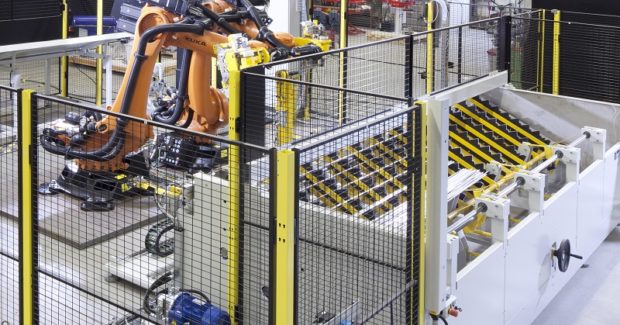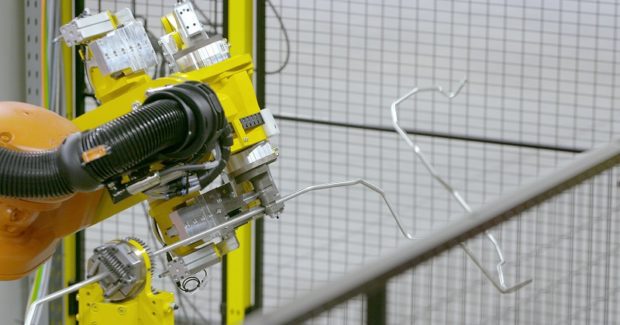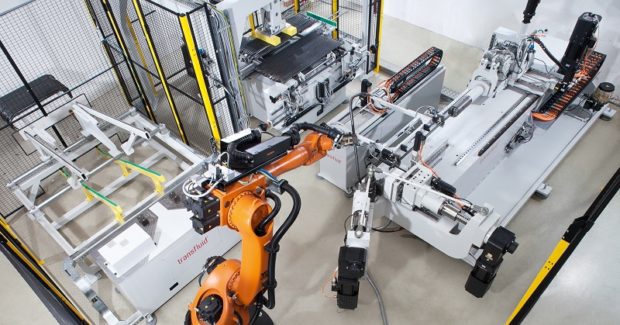Robots as Tube Bending Machines?
Instead of installing a tube bending machine and then automating it via a robot, simply use the robot itself for bending by putting a bending machine into the robot’s hand. This improved automation opens up a whole new world of process benefits.
Posted: July 13, 2017
The trend towards flexibility in machining processes with a high degree of automation is clearly expanding in tube and pipe fabrication. Yet with all of the innovative strength and performance power in such systems, we continue to ask the question: When and how does it make sense to automate? And is the robot a means to an end or the deciding factor? The enthusiasm for automation must be balanced by the diverse reasons for deciding to automate a process in the first place: Sometimes the objective is to achieve process capability and quality independent of an operator, while other applications are focused on reducing the cost of a process.
To integrate automated handling into a tube bending cell, the preferred option is defined by the functional requirements that must be met within the cell. For example, if it is necessary to cut the material prior to tube bending or forming, an integrated chipless orbital tube cutter can provide a tidy, direct route for further processing that makes it possible to form the end of the tube and bend pre-formed tubes without any delays. To integrate labeling functions or optical measurement systems, robots are certainly one option for material handling, while another option could be an electrical servo-driven 4-axis linear handling unit. Both handling systems have their appeal, but the linear system could be preferred over a robot for its shorter handling times, high speed and simplicity to program short tubes or machining prior to the bending process. Linear systems increase the degree of utilization of the integrated machines.
By contrast, a robot is a great deal more flexible when it comes to automated tube bending, so much so that it now make economic sense in some applications to employ the robot as a machine that does the pipe bending, rather than using it only for material handling tasks. Instead of installing a bending machine and then automating it via a robot, simply use the robot itself for bending by putting a bending machine into the robot’s hand. We have done this with a robot bending machine that is able to bend right-left with a single setting. It is extremely flexible, particularly in operations where long tubes have to be bent or in pipe-hose combinations where the hose has already been installed prior to the bending process.
Using a robot bending machine enables the bending head to be equipped with several levels, making it is possible to bend different tube diameters without a tool change. There is no tool change and vibration-free automation: The bending of long tubes can be automated without substantial vibrations and the bending speed can be maintained as relatively constant over the whole length. The robot has innate advantages when it comes to handling of tubes from a magazine and transferring to a storage location after processing. This allows steel tubes up to 22 mm diameter to be bent without a mandrel.
In addition to conventional bending methods, robots can also bend pre-machined tubes with an internal mandrel, which is fascinating if both ends of the workpiece have already been machined. The robot can start with the bending from both sides, which opens up an amazing opportunity to bend both ends into the final shape without an additional length being required.
With the robot bending machine, difficult programming becomes yesterday’s hurdle. Programming is not only simple with new robot bending systems, it is missing altogether because the coordinates are loaded directly from the CAD system so that the robot knows how it must bend. It is also possible to connect to measurement systems so that manual corrections can be executed very simply because the robot is operated via a normal bending machine controller. This “plug and play” operation makes robot utilization even more cost effective in individually tailored automation systems with intelligent networking of processes, from chipless tube cutting through re-forming through to bending, with integrated product marking, weld seam checking, camera checking systems or the feeding and fastening of external components such as flanges.


















